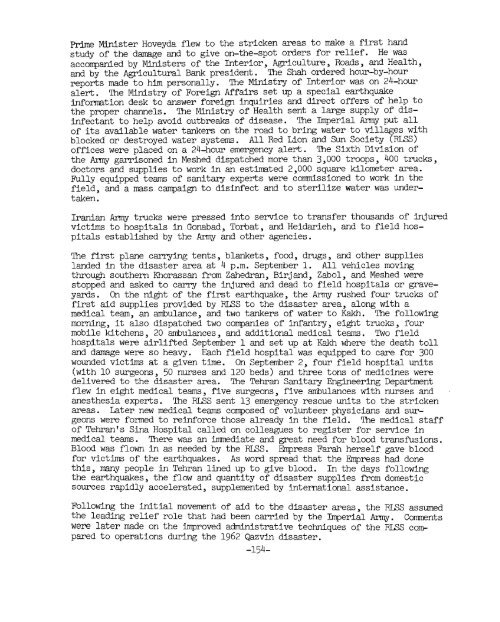3. - usaid
3. - usaid
3. - usaid
Create successful ePaper yourself
Turn your PDF publications into a flip-book with our unique Google optimized e-Paper software.
Prime Minister Hoveyda flew to the stricken areas to make a first hand<br />
study of the damage and to give on-the-spot orders for relief. He was<br />
accompanied by Ministers of the Interior, Agriculture, Roads, and Health,<br />
and by the Agricultural Bank president. The Shah ordered hour-by-hour<br />
reports made to him personally. The Ministry of Interior was on 24-hour<br />
alert. The Ministry of Foreign Affairs set up a special earthquake<br />
information desk to answer foreign inquiries and direct offers of help to<br />
the proper channels. The Ministry of Health sent a large supply of dislnfectant<br />
to help avoid outbreaks of disease. The Imperial Army put all<br />
of its available water tankers on the road to bring water to villages with<br />
blocked or destroyed water systems. All Red Lion and Sun Society (RLSS)<br />
offices were placed on a 24-hour emergency alert. The Sixth Division of<br />
the Army garrisoned in Meshed dispatched more than 3,000 troops, 400 trucks,<br />
doctors and supplies to work in an estimated 2,000 square kilometer area.<br />
Fully equipped teams of sanitary experts were commissioned to work in the<br />
field, and a mass campaign to disinfect and to sterilize water was undert<br />
aken .<br />
Iranian Army trucks were pressed into service to transfer thousands of injured<br />
victims to hospitals in Gonabad, Torbat, and Heidarieh, and to field hospitals<br />
established by the Army and other agencies.<br />
The first plane carrying tents, blankets, food, drugs, and other supp:lies<br />
landed in the disaster area at 4 p.m. September 1. All vehicles moving<br />
through southern Khorassan from Zahedran, Birjand, Zabol, and Meshed were<br />
stopped and asked to camy the injured and dead to field hospitals or graveyards.<br />
On the night of the first earthquake, the Army rushed four trucks of<br />
first aid supplies provided by RLSS to the disaster area, along with a<br />
medical team, an ambulance, and two tankers of water to Kakh. The fo1Llowing<br />
morming, it also dispatched two companies of infantry, eight trucks, j?our<br />
mobile kitchens, 20 ambulances, and additional medical teams. Two field<br />
hospitals were airlifted September 1 and set up at Kakh where the death toll<br />
and damage were so heavy. Each field hospital was equipped to care for 300<br />
wounded victims at a given time. On Septernber 2, four field hospital uni.ts<br />
(with 10 surgeons, 50 nurses and 120 beds) and three tons of medicines were<br />
delivered to the disaster area. The Tehran Sanitary Engineering Depar'tment<br />
flew in eight medical teams, five surgeons, five ambulances with nurses and<br />
anesthesia experts. The RLSS sent 13 emergency rescue units to the stricken<br />
areas. Later new medical teams composed of volunteer physicians and surgeons<br />
were fomd to reinforce those already in the field. The medical staff<br />
of Tehran's Sina Hospital called on colleagues to register for service in<br />
medical teams. There was an immediate and great need for blood transf'usions.<br />
Blood was flown in as needed by the RLSS. Rnpress Famh herself gave blood<br />
for victims of the earthquakes. As word spread that the hpress had done<br />
this, many people in Tehran lined up to give blood. In the days following<br />
the earthquakes, the flow and quantity of disaster supplies from domestic<br />
sources rapidly accelerated, supplemented by international assistance.<br />
Following the initial movement of aid to the disaster areas, the RLSS assumed<br />
the leading relief role that had been carried by the Imperial Amy. Coments<br />
were later made on the improved administrative techniques of the RLSS compared<br />
to operations during the 1962 Qazvin disaster.<br />
-154-
















